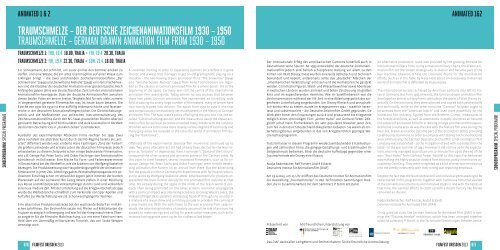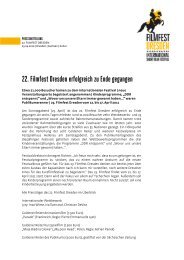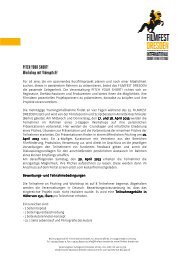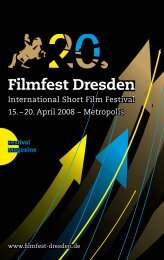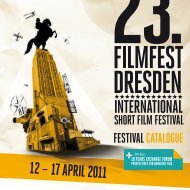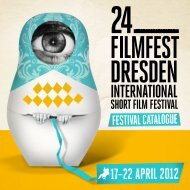25. FilmFest DresDen international short Film Festival 16–21 april ...
25. FilmFest DresDen international short Film Festival 16–21 april ...
25. FilmFest DresDen international short Film Festival 16–21 april ...
Erfolgreiche ePaper selbst erstellen
Machen Sie aus Ihren PDF Publikationen ein blätterbares Flipbook mit unserer einzigartigen Google optimierten e-Paper Software.
ANIMATED 1 & 2ANIMATED 1&2TRAuMSCHMELZE – Der deuTSCHE ZEICHENANIMATIONSFILM 1930 – 1950TraumSChmelZE – German DraWN AnimatiON <strong>Film</strong> from 1930 – 1950SONDERPROGRAMM SPECIAL PROgrammEtraumschmelze 1: THU, 18.4. 18.00, thaliatraumschmelze 2: fri, 19.4. 22.30, thaliaFRI, 19.4. 20.30, THALIAsun, 21.4. 18.00, THALIAEin Schneemann, der schmilzt, um zuvor einmal den Sommer erleben zudürfen, und eine Wespe, die ein altes Grammophon auf einer Wiese zumErklingen bringt – die zwei anrührenden Zeichenanimationsfilme „DerSchneemann“ (1944) und „Verwitterte Melodie“ (1943) von Hans Fischerkoesensind die Klassiker der deutschen Animation einer ganzen Epoche. NochAnfang der 1930er Jahre war Deutschland das Zentrum der <strong>international</strong>enAnimationsfilm-Avantgarde. Dass der deutsche Animationsfilm zwischendiesen beiden Polen ein enorm breites Tätigkeitsfeld für sehr viele, zumeistin Vergessenheit geratene <strong>Film</strong>emacher war, ist heute kaum bekannt. DieEpoche von 1930 bis 1950 ist eine auffällig widersprüchliche und facettenreichein der deutschen Animationsfilmgeschichte. Die Gleichschaltungspolitikund die Maßnahmen zur politischen Instrumentalisierung desZeichenanimationsfilms durch den NS-Staat provozierten Brüche. Aber beigenauerer Betrachtung sind Kontinuitäten und viele Graustufen in der Weltdes bunten Zeichentricks in „dunklen Zeiten“ zu entdecken.Ausläufer des experimentellen Absoluten <strong>Film</strong>s reichten bis 1939. ZweiJahre nachdem die abstrakte Kunst durch das NS-Regime bereits als „entartet“diffamiert worden war, eroberte Hans Fischingers „Tanz der Farben“die großen Leinwände und erntete Lob in der deutschen <strong>Film</strong>presse. Jedochentwickelten zu diesem Zeitpunkt schon einige bedeutende <strong>Film</strong>emacher,wie z.B. George Pal, Peter Sachs und Oskar Fischinger den Animationsfilmkünstlerisch im Exil weiter. Eine Nische für Form- und Farbenexperimentein Deutschland bot der Werbefilm, wie die Arbeiten von Wolfgang Kaskelinebezeugen. Die Produktwerbung war Hauptbetätigungsfeld der Animationsfilmbranchein jener Zeit. Allerdings gab es Wirtschaftspropaganda mit politischemEinschlag schon im Verlauf der 1930er Jahre inmitten der buntenWarenwelt auf der Leinwand: Bei Georg Woelz ziehen in einer Mischungaus Revue und Militärparade Volksempfänger durchs Land und verkündeneine neue mediale Zeit. Mit der Umstellung auf die Kriegswirtschaft ab 1939wurde die Werbebranche schließlich zum Verkünder von Spar-Apellen undAufrufen zur Werterhaltung wie z.B. Schonwaschgänge für Textilien.Eine alternative Produktionsstrecke bot der wachsende Bedarf an militärischenLehrfilmen. Der Zeichenfilm setzte mit Pfeilen auf Militärkarten dieTruppen strategisch in Bewegung und war Teil der Kriegsmaschinerie. Ebensosorgte er für die filmische Mobilmachung, u.a. mit einer Fabel von HansHeld über ein übermäßig militarisiertes Tierreich, das von Stuka-Wespenverteidigt wird.A snowman melting in order to experience summer once before it is goneforever, and a wasp that manages to get an old gramophone playing on ameadow – the two moving drawn animation films "The Snowman" (1944)and "Weatherbeaten Melody" (1943) from Hans Fischerkoesen are regardedas the classics in German animated film for a whole epoch. Yet at thebeginning of the 1930s, Germany was still the centre of the <strong>international</strong>animation film avant-garde. Today almost no one realises that betweenthese two poles, German animation film represented an incredibly widefield of activity for a very large number of filmmakers, many of whom havenow mostly slipped into oblivion. The epoch from 1930 to 1950 is one thatwas conspicuously contradictory yet multifaceted in the history of Germananimation film. The Nazi state’s policy of bringing the arts into line, the socalled"Gleichschaltungspolitik", and the measures to usurp the drawn animationfilm for political purposes provoked many breaks with the industry.Yet when we look at this area more closely, various degrees of continuity andmany grey areas are revealed in the colourful world of animation film duringthe "dark times".Offshoots of the experimental absolute film movement continued up to1939. Two years after abstract art had already been decried by the Nazi regimeas "entartet" or degenerate, Hans Fischinger’s "Dance of the Colours"conquered the silver screens and garnered praise in the German press. Bythis point in time however, several important filmmakers, such as for instanceGeorge Pal, Peter Sachs and Oskar Fischinger, were in exile developinganimation film further on an artistic level there. But the advertisingfilm did provide a niche in Germany for experiments with forms and colours,as the works by Wolfgang Kaskeline attest. Advertisements for products representedthe main field of activity for the animated film industry at thattime. Yet already during the 1930s in the midst of the brash world of productsthen being promoted on the silver screens, economic propagandawith a political impact was also being screened: In Georg Woelz’s piece, theVolksempfänger (Nazi people’s wirelesses) head off through the country ina mixture of a revue show and a military parade to proclaim the coming ofa new media era. With the switchover to the war economy from 1939 onwards,the advertising industry ultimately assumed the role of announcingappeals to make savings and calling for preservation measures, such as forinstance having gentle wash cycles for clothes to last longer.Der <strong>international</strong>e Erfolg des amerikanischen Cartoons hinterließ auch inDeutschland seine Spuren. Ab 1933 entwickelte der deutsche Zeichenanimationsfilmjedoch eine beinah schizophrene Haltung vor allem zu den<strong>Film</strong>en von Walt Disney. Diese wurden einerseits ästhetisch und technischbewundert und kopiert, andererseits sollte das „deutsche“ Märchen der„amerikanischen Verkitschung“ entrissen und die Heimatbranche gestärktwerden. Grimmsche Figuren, Wald- und Wiesenbewohner sowie Abenteuerin exotischen Ländern wurden animiert und boten Zerstreuung im großenKino und im expandierenden Heimkino. Wie im Spielfilmbereich war dieZeichenanimation während der NS-Zeit in eine Ablenkungspolitik der sorgenfreienUnterhaltung eingebunden. Um Disney filmisch und wirtschaftlichKonkurrenz zu bieten, wurde im Kriegssommer 1941 – staatlich veranlasstund subventioniert – die Deutsche Zeichenfilm GmbH gegründet. Sieblieb aber hinter den Erwartungen zurück und produzierte bis Kriegsendelediglich einen 17minütigen <strong>Film</strong>: „Armer Hansi“ von Gerhard Fieber. Zeitgleichschuf Hans Fischerkoesen die sehr populären Klassiker jener Zeit,zum Teil in den durch Deutschland okkupierten Gebieten. Sie waren als Unterhaltungsbonuseingebunden in das von Kriegsberichten geprägte Wochenschauprogramm.Trotz brillanter in diesem Programm wiederzuentdeckender Einzelleistungenund zahlreicher <strong>Film</strong>e, die gängige Gestaltungs- und Erzählmuster imZeitgeschmack bedienten, blieb die deutsche Aufholjagd gegenüber einerTraumschmiede wie Disney eine Illusion.Nadja Rademacher, Ralf Forster, André EckardtDeutsches Institut für Animationsfilm (DIAF)Am 19.4.2013, um 15 Uhr eröffnet das Deutsche Institut für Animationsfilmdie Ausstellung „Traumschmelze“ in den Technischen Sammlungen Dresden,die in Zusammenarbeit mit dem Sammler J.P. Storm entstand.Präsentiert vonMit freundlicher Unterstützung vonAn alternative production route was provided by the growing demand forinstructional military films. Using arrows on military charts, the drawn animationfilm set the troops strategically in motion and became part of thewar machine. Likewise, it beat the cinematic drums for the mobilisationefforts, such as in the fable by Hans Held about an excessively militarisedworld of animals that is defended by Stuka wasps.The <strong>international</strong> success achieved by American cartoons also left its tracesin Germany. But from 1933 onwards, the German drawn animation filmdeveloped an almost schizophrenic attitude to the works of Walt Disney especially.On the one hand, they were admired and copied both aestheticallyand technically, while on the other hand the "German" fairytale ought tobe wrested from the "American kitsch" and used more powerfully for thehomeland film industry. Figures from the Brothers Grimm, inhabitants ofthe forests and fields, as well as adventures in exotic countries all becamethe subject of animation films for screening in large cinemas and the expandedhome cinema area. As was the case with the feature film area during theNazi era, drawn animation became part of the distraction policy providingcarefree entertainment. In order to compete with Disney both cinematicallyand commercially, the German Deutsche Zeichenfilm GmbH animation filmcompany was established – at the instigation of and with subsidies from thestate – in the war summer of 1941. However it did not live up to the expectationsand only managed to produce one 17-minute film up to the end of thewar: "Poor Hansi" from Gerhard Fieber. Parallel to this, Hans Fischerkoesenwas making the highly popular classics from that era, partly in territories occupiedby Germany. They were integrated as a kind of entertainment bonusinto the weekly news reels with their strong war reporting emphasis.Despite the fact that there are several brilliant individual gems waiting to berediscovered in this programme, together with numerous films that availedof the conventional structures and narrative styles in line with the tastes atthat time, the German efforts to catch up with a dream factory like Disneyremained an illusion.Nadja Rademacher, Ralf Forster, André EckardtGerman Institute for Animated <strong>Film</strong> (DIAF)On 19.4.2013 at 15.00, the German Institute for Animated <strong>Film</strong> (DIAF) is openingthe "Traumschmelze" exhibition, which has been arranged togetherwith the collector J.P. Storm, in the Technische Sammlungen Dresden venue.SOONDERPROGRAMM SPECIAL PROgrammE070 FILMFEST DRESDEN 2013Das DIAF dankt allen Leihgebern und Rechteinhabern für die freundliche Unterstützung.FILMFEST DRESDEN 2013 071


